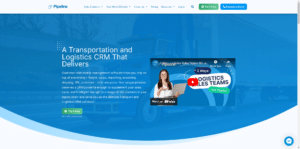“Call me back in two weeks.”
Customers take their time, dragging deals out for weeks or months after they’ve requested information from your company. Marketing looks at you, wondering what your salespeople are doing. Your sales team complains about lead quality.
But your deals aren’t closing.
Who’s to blame for all of this? Is it sales, or is it marketing? Are managers failing because they haven’t whipped their sales team into shape?
None of the above.
Have you looked at your sales workflows?
Sales workflows are often ignored.
Organizations tend to approach them with a set-and-forget attitude; they invest the time to create a solid workflow, then they either don’t use it, or they use it blindly without any kind of analysis. Many companies operate on an “If it’s not broke, don’t fix it” mindset.
This attitude sets sales teams up for failure.
It creates sales leaks in your funnel — deals your company should have won, revenue your company should have earned but failed to do so for one reason or another.
Remember the 3% Rule?
It states that only 3% of your prospects are ready to buy at any given moment. What about the rest?
- 7% plan on making a change
- 30% have a need, but they’re not ready to buy
- 30% don’t have a need
- 30% will never buy from your company (even if they have a need)
Now let’s take a look at the sales process your workflow needs to address.
- Prospecting
- Rapport building
- Disqualification
- Prospect nurturing
- Make your pitch
- Defuse objections
- Close
Did you catch it?
The issue that causes customers to drag their feet after they’ve requested information from your company?
Here’s the answer.
It’s steps three and four — disqualification and prospect nurturing. These are the issues that slow your sales cycle down significantly.
Here’s why:
- Marketing is under tremendous pressure to generate high-quality leads at low cost. They generate leads alright, but they allow unqualified customers into your sales funnel — the 97% who don’t belong in your sales funnel (they belong in your lead nurturing funnel.
- Your salespeople are responsible for generating some or all of the needed leads. The problem is that most salespeople aren’t disqualifying their leads. They don’t know how to nurture their leads, and they waste time trying to close the 97%, while the 3% are ignored. They don’t know which prospect is which.
- Marketing managers want to justify their budgets and avoid blame, so they’ll send sales as many marketing-qualified leads (MQLs) as they can. This works especially well if there isn’t an agreed-upon metric or KPI that defines what a quality lead looks like.
- Sales managers are just as hungry as their sales team. They want to close as many of these customers as possible or kick these leads back to marketing (as they should). But many sales managers are far more inclined to blame their salespeople. ‘It’s not the lead/territory/product that’s to blame; it’s the salesperson.’
None of these people want to throw good leads away. That’s the problem; many of the leads they receive aren’t a fit. They should be disqualified or nurtured.
Why these sales workflows are vital
Sales workflows are must-haves for several reasons. Workflows:
- Create consistent outcomes
- Boost team productivity and provides methods of evaluation
- Enable teams to spot errors, make corrections, and iterate
- Segment customers (i.e., if you ask “what’s your timeframe” and customers can’t answer, they’re disqualified)
- Give you a stable platform you can use to run split tests
- Help managers identify A-players and C-player employees
- Provide day-to-day steps sales reps can follow to reach individual, department, and company goals
It’s an easy way to keep your managers, stakeholders, and team on the same page. This is what sales workflows do for your sales team.
Why are workflows in these two categories, disqualification and prospect nurturing, so important?
- Disqualification workflows: These workflows verify that (a.) your salespeople are working with the 3% of active buyers who are ready, able, and willing to buy, and (b.) You’ve successfully segmented your prospects into the right buckets (e.g., nurture, disqualify, or blacklist). This is crucial because it ensures your salespeople are always spending time with active buyers (or nurturing the 7% who will make a change in the near future).
- Nurturing workflows: These workflows tell you how to nurture your leads and who should be responsible for doing so. If your prospect is part of the 7% (e.g., plan on making a change in the near future), you can add them to a lead nurturing automation sequence that sends them educational content they’ll need to make a purchase decision. If they’re part of the 30% (e.g., they have a need but are not ready to buy), you can send these leads back to marketing for longer-term lead nurturing and follow-up.
This is the clarity most sales teams lack.
Using these sales workflows to close deals 3x faster
So we’ve talked about the workflows you need. If we’re going to shorten our sales cycles, we’ll need to take a look at the prospects we want and the ones we need to avoid.
1. Find the prospects you want
If you’re like most companies, you’re looking for customers who are able and willing to buy. These customers are transparent; they’ll share their information with you.
How do you find them?
It’s easy, you talk with marketing and accounting.
- Head over to marketing and ask for a record of the leads they’ve sent you in the last 3-6 months.
- Pull your sales data and see which leads became customers
- Take this list of customers over to accounting. Get financial data on these customers (e.g., repeat sales, average order values, upsells, etc.)
- Take your list of customers (and the financial data you’ve received) back to marketing. Ask marketing for the demographic, ethnographic, ethnographic, and firmographic data on these customers. Ask for the marketing channels that brought these customers in.
- Train your sales team to recognize these customers. Work to shepherd these prospects through your sales funnel, giving them the attention and support they need. Focus your time and attention on these active customers.
2. Identify customers who aren't a fit
These are the 30% of prospects who don’t have a need or, for whatever reason, aren’t a good fit.
- They’re unable or unwilling to buy (e.g., no budget, trust, interest, etc.)
- They don’t need your product or service (e.g., avoid them even if they’re willing to buy)
- They aren’t interested or can’t be bothered to respond to your sales team’s request
- Requested your help (e.g., a quote, proposal, consultation, trial, etc.), but they’re uncooperative or difficult to work with
- They have poor boundaries, or they’re unwilling to work with you to solve their problem
You have your own list.
Work to expand that list but make sure that the primary identifier is clear — they don’t need your product or service.
3. Flag the prospects you want to avoid
Work to avoid customer predators.
- The Arranger manipulates circumstances, deals, and events. These customers structure deals, so everything is win/lose in their favor. They demand products you don’t offer, require expensive concessions that only benefit them, change terms and agreements, and push for massive discounts.
- The Corrupter is a liar. These customers are consistently dishonest and unethical. They’ll do or say anything to get what they want. They will lie to your face, ask you to lie for them, lie on you and your employees — anything to get what they want.
- The Disruptor craves control. These customers want what they want. They are inflexible, believe they deserve the best and will accept nothing less. They boss your employees around and talk down to them. They don’t think the rules apply to them; they’ll throw epic tantrums when they don’t get their way and attempt to bully you to get what they want.
- The Slanderer uses guilt, shame, and fear to punish and control. These customers play the role of the persecutor; they use verbal abuse, emotional blackmail, coercion — anything to break you. When you lose your composure, they immediately switch to the victim, using your behavior as justification to blame you, break their promises, push for concessions, or seek revenge.
- The Schemer hunts for loopholes. They’re resourceful customers, searching for a way over, under, around, or through your rules. These customers are all about gaming the system. Offered a 50% discount? They’ll claim it was 60% or use the coupon in unintended ways. Offering a money-back guarantee? They’ll use your product or service and then abuse your loophole, demanding a full refund.
Avoid these customers like the plague.
Train your sales team so they can recognize these monsters-in-disguise. Create a workflow your salespeople can use to loop managers into the process. Confirm their identity, collect evidence, work towards a peaceful resolution, then quietly show these prospects the door.
Get them to leave peacefully.
Then, notify marketing, so they’re permanently blacklisted.
Don’t provoke them.
At this point, you're ready to create your workflows.
Create or modify a list of workflows for each group. You’ll want to define your process from A to Z. Outline every step of the sales process. What are the first ten things your sales them should do when a lead comes in? You’ll want to create disqualification, lead nurturing, and termination workflows for each segment.
What are the goals for each of these three segments?
- Disqualification: This workflow is designed to separate the wheat from the chaff.
- Prospect nurturing: This provides prospects with helpful, educational, and valuable information they need to make their purchase decision
- Termination: These workflows protect your company from predatory customers who aren’t interested in buying products or services at full price. They’re takers who should be avoided at all costs.
Can you see what’s happening?
If you focus on these three workflows — customers you want, those that aren’t a fit, prospects to avoid — you’ll have the tools you need.
Sales workflows help you to close more deals 3x faster
When customers take their time dragging deals out for weeks or months after requesting information, it’s a signal. Your customers may be predators, or they may simply not be a fit. Regardless, it means your deals aren’t close
Your workflows may be to blame.
Companies tend to approach them with a set-and-forget attitude; they invest the time to create solid workflows, then they fail to use them properly. Many companies operate on an “If it’s not broke, don’t fix it” mindset.
This attitude sets sales teams up for failure.
You know the truth.
Focus your attention on the prospects you want, don’t want, and want to avoid. Follow the steps I’ve covered here, and you’ll find you have everything you need to close your deals 3x faster




